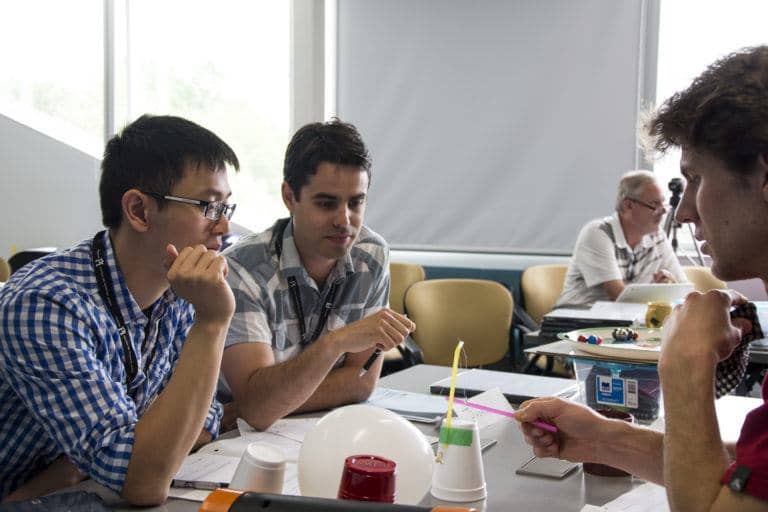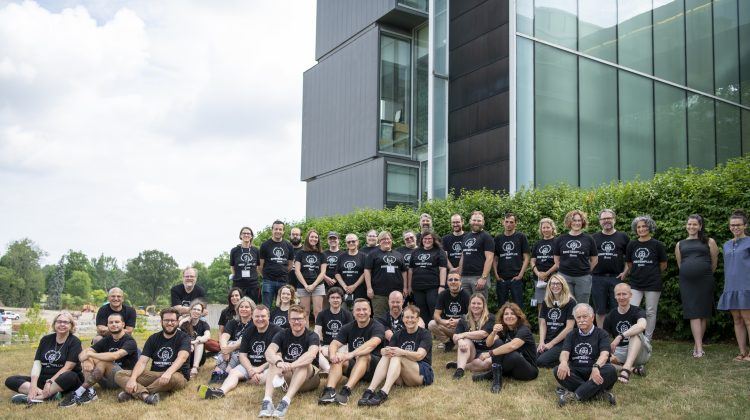Back To The Classroom
How do you get black holes and quantum mechanics into high school classrooms? EinsteinPlus shows teachers some neat new tricks.

It’s the coffee break on the third day of the boot-camp for high school physics teachers that’s known as EinsteinPlus.
Twenty-odd teachers have gathered at the tables in the peacock-blue workroom usually filled with graduate students. Some are deep in conversations, some are scribbling in notebooks, some are staring into space, and a handful are playing with the toy plastic poppers that have been set out for the next exercise.
They’re about to start a session called Black Holes Part One. It’s the fourth session of the day – they’ve already been through Cosmology Parts One, Two, and Three.
“I’m starting to understand what some of my kids go through,” says Michael Strange, who teaches physics and coaches soccer at Kennedale High School, south of Arlington, Texas. “I think my brain might be full.”
“Could we put the poppers away, please?” The facilitator, Karen Jo Matsler, has a no-nonsense manner that comes from 20 years teaching high school physics. She puts three discussion points on the board:
- How do we know there are black holes and how do we find them?
- Why is time dilated near a black hole?
- How does light behave near a black hole?
She assigns one question to each table and gives the teachers two minutes to discuss it before cutting them off. “I want you to write down something about your question,” she says. “It doesn’t have to be right. But I want you to commit to something.”
The teachers, it seems, have become the students.
There’s a quick change of gear and a discussion breaks out on how to use warm-up exercises like this to engage students without intimidating them. But then it’s right back into the student role – out come the poppers.
Poppers are like hollow rubber balls that have been cut in half. When they’re turned inside out, they become unstable and leap off the table with surprising force. The teacher participants are asked to predict how fast the poppers leap, then each table tries to design an experiment to measure the popper’s launch speed.
Half spheres of neon-coloured plastic go flying everywhere. The room fills with chatter and the click of calculators. One group is doing a video analysis with a smartphone. Everyone has a yardstick held up. The group at the front of the room is scribbling equations on their whiteboard.
Just five minutes later, they’re comparing results. Equations fly fast.
“Teacher hat,” says the facilitator, and outlines the stages of learning they’ve just passed through: engage and explore. The PowerPoint shows one way this problem can be solved. The class then flies through another set of exercises, connecting launch velocity to escape velocity – the speed it takes to leave the orbit of a planet or a star. It’s just 20 minutes into the workshop, but the teacher-students have already reached outer space.
Next, Perimeter’s own Damian Pope – a physics PhD with an interest in the history of science – takes over as facilitator. He poses a surprisingly simple question: What would happen if the escape velocity was greater than c, the speed of light?
Bang: we’re in a black hole.
Welcome to EinsteinPlus. The thesis of the program is that modern physics is closer than you think. It can – and should – be brought into high school classrooms, because it’s where the really cool ideas are – the mind-bending ones that can really engage kids’ imaginations and ingenuity. And for almost a decade, with hundreds of teachers, EinsteinPlus has done just that.
Stacey Harvey, who teaches math and physics at a small school in Saskatoon, Saskatchewan, agrees: “Kids have a lot of questions about modern physics. They hear about it online. They’re talking about it with their friends. Some of them are reading about it. Even now, in my classes, kids come in talking about quantum stuff and asking questions. We look things up together. But it happens mostly at breaks and at lunch.”
Things are changing, however, she adds. “We just got a new curriculum in Saskatchewan. There’s going to be some quantum mechanics and other modern physics in the curriculum. I’m very excited, and I think the kids will be too. This is what is happening in science right now. This is where the excitement is.”
Michael Strange agrees: “My kids are interested in black holes, in where the universe came from, in quantum mechanics. They like the big questions.”
EinsteinPlus gives teachers the tools to explore today’s new material in the classroom – literally the tools, in Harvey’s case. “I didn’t get my physics equipment ordered before I left, and it’s a good thing,” she says. “Every night, I’ve been e-mailing the secretary ordering things. Polarization glasses. Stretchy fabric. Those poppers went on the list today. Next year’s class is going to have so much fun.”
“Fun” is the key word. What the teachers are most interested in recapturing is the feel of the program – the dive-right-in, get-your-hands-dirty appeal of science as scientists do it.
“I like the emphasis on science as a model,” says Harvey. “There was a Newtonian model of gravity and now there’s the relativity model of gravity. These are the features of those models. This is how they came about. These are their limitations. It is better for students to understand models than it is for them to memorize facts.”
“My kids aren’t ready to tackle the mathematics of modern particle physics,” says Strange. “I wouldn’t even try to teach them that. I’d just lose them. But they can learn the feel of modern particle physics – they can get a taste of how it was discovered and how it fits together.”
“I know they can learn it,” Strange goes on. “I’m sure they can, because I just learned it yesterday. It was an amazing feeling of discovery. I can’t wait to share it.”
– Erin Bow
FURTHER EXPLORATION























































































